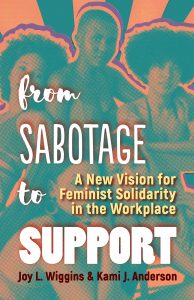In this article, I will frame a lot of questions for you to consider when examining your recruitment and retention efforts. I am not expecting you to immediately address all of these questions, but they are a good roadmap to help you along. Through my work with my co-author, Joy L. Wiggins, and as an academic and entrepreneur, I have seen that the more women know about their history, their social conditioning, their varying degrees of power and privilege, and their biases, the better equipped they are to stand in solidarity with each other.
 In our book, “From Sabotage to Support: A New Vision for Feminist Solidarity in the Workplace,” we address how women have stood in each other’s way or sabotaged each other throughout history. We contend that if we learn from our differing histories, our biases, and our own internalized oppression and come together across those differences, we can push equity forward for all of us, rather than just for some of us. The ability to identify and curb sabotage makes it possible for us to push past it. Knowing what sabotage is breaks open those locked doors of miscommunication and isolation so that we can move toward empowerment, solidarity, and, finally, liberation to be our authentic selves in whatever way that looks like for us.
In our book, “From Sabotage to Support: A New Vision for Feminist Solidarity in the Workplace,” we address how women have stood in each other’s way or sabotaged each other throughout history. We contend that if we learn from our differing histories, our biases, and our own internalized oppression and come together across those differences, we can push equity forward for all of us, rather than just for some of us. The ability to identify and curb sabotage makes it possible for us to push past it. Knowing what sabotage is breaks open those locked doors of miscommunication and isolation so that we can move toward empowerment, solidarity, and, finally, liberation to be our authentic selves in whatever way that looks like for us.
Many times sabotage manifests as tension or internal conflict between employees. What does your organization do in the event of internal conflict? Is there a protocol to help alleviate intergroup tension? Once race-based conversations are facilitated skillfully, and the participants can see how they might examine their privileges and marginalizations and find ways to become allies, then real change around racism can occur — but these conversations have to be ongoing and sustainable. We want to emphasize that you may or may not have the ability or access to change some of these situations, but you may know the folks who do and that’s a step in the right direction.
Some questions to think about for your organization:
- When examining hierarchy, how might your organization examine its policies and procedures to actively recruit women, people of color, and people of diverse backgrounds and abilities?
- What are the exact policies and procedures around recruiting a diverse pool of people?
- Does your company prioritize attendance at national, state, and local recruitment fairs in diverse areas to directly seek diversity?
- Are there other ways to check for implicit biases that take someone off the top of the applicant list?
- In what ways are judgments suspended to ensure the applicant’s qualifications so they aren’t being judged on their identity?
- What does “good fit” look like, exactly? And how might you examine potential for bias?
When we begin to define how we can show support for someone, the first word that may come to mind is “allyship.” Allyship is an ascribed term (meaning it is best for someone to name you an ally before you name yourself one) that focuses on the ways we use our voice, power, and influence to stand in solidarity with women who are marginalized or silenced in our spaces. But what’s important to know — and this may be a little hard to swallow — is that ally is a title that is given, not claimed. We want to make sure that we don’t just assert ourselves as allies; that’s for the other person to determine. To truly be an ally involves giving evidence of your work in defense for, in support of, and for the uplifting of the group for which you are claiming allyship. Being an ally is work. At times it can be ugly or hurtful, and it can be exhausting. This work is necessary in making sure that we are moving forward on a path of support within the workplace.
Moving to a place of support begins with our own self-awareness. Let’s look at microaggressions in the workplace and where they tend to be common. If given the opportunity to correct your behavior, how might you recast a microaggression that either happened to you or that you perpetuated? A simple way is to practice self-correcting behavior. In our book, we recall an experience Joy had in the elevator when her colleague talked about how “huge” Joy used to be, placing her arms out in front of her to show how big Joy’s breasts had been. This could have been perceived a number of different ways by Joy, but people who struggle with their weight are usually fine with such comments if they have told people at work that they are trying to lose weight and discuss it openly, or if they are perfectly happy with their body in its current state. This wasn’t the case in Joy’s situation. She didn’t know the woman that well; she had just started working there and had never discussed her weight before. She could tell that the woman started to realize that what she was saying was probably inappropriate and insulting, but she never said anything to Joy. The woman from that incident could have reflected on her words and later approached Joy to say, “I realized I might have insulted you with my comments about your weight. I’m so sorry about that.” This is a great way to self-correct your behavior and in general make sure you are more mindful of the impact your words can have on others. This is not an easy task. It takes effort and can sometimes feel uncomfortable. Below, we offer a few additional tips for self-correcting behavior:
- Reflecting on your language and behavior
- Pausing and breathing if you think you may be sending a negative or biased message
- Reflecting on why you think a certain thing about someone — what’s the history behind that thought? This is where our socialization around race, gender, ethnicity, and sexual orientation is helpful.
- Internally reflecting and changing your words and actions
- Checking in with the other person to see their interpretation. The woman above could have checked in with my friend to see if she was insulting.
- Apologizing and continuing to check in with how you can change the thoughts and actions behind the behavior
- Asking the person how you might move forward in solidarity with them. This is important because you may think you are doing the right thing but you need to see if that’s actually what the person wants. The woman above could have checked in with my friend to see if she did insult her and how she can remedy from here on out.
This may seem overwhelming or “too much” for you. But the truth is that these behaviors are what constructs allies. Are you willing to take these self-reflective actions to correct behaviors in your workplace? Are you willing to help others do the same? This type of support in the workplace can allow the space for women to be more authentic and show up in their fullness without fear of judgment or retaliation.





